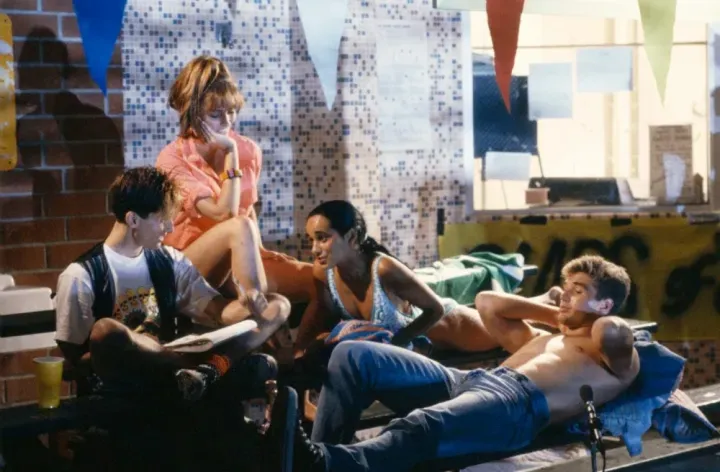
Horror sequels are typically pretty awful. There are exceptions, of course. Evil Dead 2 is more beloved than the first one, and both Halloween III: Season of the Witch and Friday the 13th: The Final Chapter have their devoted fans. But those films are exceptions to the rule. For every Evil Dead 2, there are hundreds of The Exorcist IIs.
In the A Nightmare on Elm Street series, the third entry, The Dream Warriors, is generally considered the best sequel. It delved into Freddy Krueger’s origin, brought back original series star Heather Langenkamp, and featured a cast of rising actors that included then-unknowns Patricia Arquette and Laurence Fishburne.
But for me, the standout entry in the series, if not quite its best, is A Nightmare on Elm Street 5: The Dream Child. Released on August 11, 1989, the film was the least successful Nightmare movie at that point, making a measly $22 million at the box office. (The previous entry, The Dream Master, had grossed over double that number). It pissed off fans too, because it veered too far away from the standard slasher thrills of its predecessors. Instead, it embraced the abstract and weird, blending elements from the ’80s-era works of David Lynch and David Cronenberg to create something experimental (for its genre), catastrophic (for its box office), and rewarding (for the legacy it leaves behind).
An intro to something different
The Dream Child telegraphs that it’s going to be something different, and special, with its title sequence, which sets the otherworldly tone right away. Backed by an electronic score that uses a strange, wordless lullaby to set the mood, the first images we see are abstract shapes bathed in a cool, blue light. Gradually, we see that these shapes are two human bodies in Alien: Earth , and by the end, these two bodies are revealed to be Alice (Lisa Wilcox) and Dan (Danny Hassel), the only survivors from the previous film.
This sequence tees up the odd, dreamy pull the movie will have through its running time, and establishes a key plot point: their lovemaking will produce the titular dream child, which will allow Freddy to come back. Nightmare movies usually begin with fakeouts that end with gory deaths; who can forget Part 3‘s dream world filled with junkyard cars and dogs that piss fire?
So it’s significant that The Dream Child eschews tradition, and the bloodlust in its audience to immediately see a really cool kill, to try for something different. It lulls you into its own dream world filled with strange, erotic shapes, and only hints at all the horror that is sure to come.
It fails as a traditional horror film, but succeeds as something else

From there, The Dream Child throws a lot of plot at you so it can get to what the audience wants. Alice and Dan are graduating high school, and they celebrate with their friends: the aspiring model Greta (Erik Anderson), comic book nerd Mark (Joe Seely), and the no-nonsense jock Yvonne (Kelly Jo Minter). Freddy is resurrected, in a fashion similar to the “somehow, Palpatine has returned” throwaway manner that Star Wars: The Rise of Skywalker tried to pull off, and he begins killing again even though his victims are awake. In a clever plot twist, Freddy is using the dreams of Alice’s unborn male child (he’s named Jacob; we know that because Alice daydreams and talks to a 6-year-old version of him) to get to his victims, and is intent on possessing him when he is born.
After that wowza of an intro, the film reverts to a traditional Nightmare movie: the people you except to die, die (with one notable exception I won’t dare spoil here), the adults are no help at all, and Freddy does what Freddy does: cracks jokes and flash his razor glove a lot.

It’s worth noting here that in some aspects, The Dream Child is an utter failure. As a scary movie, it fails; there’s not one genuine jump scare to be had. As a splatter movie, it fails; only three people die, and they die so outrageously, you’re more impressed by the visual effects and makeup than grossed out by them. And Freddy himself is a punchline; the boogeyman from parts 1 and 2 had, by 1989, became a court jester more concerned with elaborate disguises and one-liners than killing people.
What sets The Dream Child apart

So what about The Dream Child makes it so special? It brought together the nightmarish feeling of a Lynch film with the body horror of a Cronenberg movie to tell a story about the anxieties of impending motherhood. Long before the “Elevated Horror” era that brought us such movies as Hereditary and Lamb, The Dream Child did it first — and perhaps more honestly than its successors.
Pregnant with with her dead lover’s child, the working-class teenaged Alice faces some tough choices. Should she keep the baby? And if so, how will she be as a mother? Is a child bad, like Freddy was, or is it taught to be bad, like Freddy is doing to Jacob? And just what happens in a womb anyway?

All of these questions, and all of these anxieties, are addressed in clever and unsettling ways. When Alice gets an ultrasound, she doesn’t just see a fuzzy image of the strange shape growing inside her — she also sees Freddy feeding her child the souls of her dead friends he just killed. Yuck! This sequence lays bare any mother’s anxiety about the health of her unborn baby (Alice can’t stop Freddy from feeding Jacob) and the utter oddness of this thing, this seed of a new life still forming, that is growing inside her.
Abortion is addressed too, albeit in a way that is pretty clever for an Reagan-era horror flick. When Mark suggests getting rid of the child is an easy way to quickly, and cleanly, eliminate Freddy, Alice refuses to even entertain that thought. “He’s part of me now,” she explains. Now, this is a complicated issue, one that is still debated about today, and here’s a cheap horror sequence tackling both sides of the pro-life/pro-choice debate with a blunt simplicity.

Mark isn’t wrong — aborting Alice’s baby would solve a lot of problems (and would’ve saved his life, as he’s the next one to go). But Alice isn’t wrong either –even though Jacob is technically just a fetus, she’s already imagined it as a human being she wants to raise on her own.
How the horror sequel was ahead of its time

The Dream Child culminates in a wild, fantastical battleground straight out of an M.C. Escher painting, with Alice frantically trying to save Jacob’s soul from Freddy’s influence by navigating a maze of upside-down staircases that lead to everywhere and nowhere.
In a scene that would make Cronenberg proud, she draws Freddy from her subconscious by physically pulling him from her own body. Freddy starts to grow from Alice, pulling away his burned body through her face (with a quick, disgusting shot of Freddy tonguing Alice as extends his jaw from hers) and gradually taking over her own body. Watch for yourself below:
With help of Freddy’s mom, Amanda, another mother whose fears of her child being evil have tragically come true, Alice defeats Freddy and saves Jacob. In a striking sequence, we see Amanda, clad in a pure white nun’s uniform, hold Freddy, now de-aged into a tiny, demon-like creature, and Alice hold Jacob, who is de-aged into a newborn, and both mothers absorb their child’s essence into their wombs.

Does it make sense? Not really. And I’d be lying if I said the film is some kind of a masterpiece or even completely satisfying. (This is a film, after all, that has dialogue like “I must be released from my earthly prison!” and treats most of its supporting cast as meat to be sliced and diced by its villain). It has a lot of flaws that are inherent in a fifth entry of a franchise that had, by 1989, been rendered irrelevant by the rise of comic book blockbusters like Batman and glossy action movies like The Abyss.
But it’s striking how The Dream Child was committed to seeing its metaphor of motherhood through, and how it addresses something deeper, and more complex, in ways that many horror movies then and now fail to accomplish. Through its stylized visuals, nontraditional narrative flourishes, and singular focus on its main character’s plight as a nervous expectant mother, The Dream Child established itself as more than just another Freddy sequel. Although its not nearly as good, it has more in common with such horror classics as Rosemary’s Baby and The Brood than its bad reputation suggests.
A Nightmare on Elm Street 5: The Dream Child can be rented or purchased at various digital vendors. The Internet Archive has the uncut version available to stream for free.



